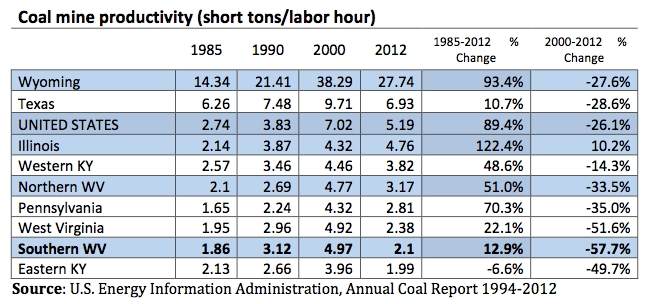In the last post, I showed that the decline in coal production was heavily concentrated in the southern part of the state. While there are many factors at play, none is probably more important than this one.
#2 lower productivity is at heart of coal decline in W.Va.
If you want to understand why West Virginia and Central Appalachia coal production is struggling, the first place to look is productivity or the amount of coal being produced per hour of work. Productivity is the sine qua non of coal mining. It plays a large role in determining the price of coal, the costs of mining coal, and the profits being made from coal. It also helps explain why some mines are shutting down at the same time others want to open that are less than 100 miles apart.
As the table below highlights, West Virginia – especially southern West Virginia – ranks in the bottom of coal mine productivity. Wyoming can produce 13 times as much coal per hour of work than West Virginia, while Illinois is twice as productive. While Wyoming and Illinois coal has less heat content or BTUs than coal from West Virginia, it still comes out way ahead with Wyoming producing 244,000 BTUs per miner hour compared to just 26,000 in southern West Virginia.

Between 2000 and 2012, coal mining productivity has declined by over 50 percent in West Virginia, from about 5 tons per hour to 2.4 tons. As the table makes clear, this is largely being driven by the decline in productivity in southern West Virginia. Meanwhile, productivity in Wyoming – the country’s largest coal producer – has only declined by 27.6 percent and productivity in Illinois – the country’s 5th largest coal producer – has improved by 10.2 percent.
In most industries, productivity rises each year as technology improves.But with coal mining, the gains since the mid-1980s have not been uniform. Since 1985, productivity has barely budged in Central Appalachia, with eastern Kentucky seeing a decline of almost 7 percent and southern West Virginia with an increase of only 13 percent. Meanwhile, productivity has grown by 122 percent in Illinois, 93 percent in Wyoming and about 50 percent in western Kentucky and northern West Virginia.
The drop in coal mining productivity, despite technological improvements, in West Virginia and the Appalachian region reflects the depletion of the area’s coal reserves. As coal seams get thinner, they becomes more expensive to mine. As Downstream Strategies highlighted in its excellent 2012 report, the central reason for the sharp declines in productivity in Central Appalachia has been the “the exhaustion of the thickest, most accessible coal seams.” Other factors impacting productivity include demand for coal, mining costs, workforce demographics, mine permitting, and regulatory oversight.
The drop in productivity from the depletion of the area’s coal reserves can also help partly explain the growth in the value of the state’s reduced severance tax rate for thin-seam coal production.

According to experts, there also do not seem to be any technological improvements that will increase productivity in the future. The latest projections from the U.S. Energy Information Association also confirm this finding showing that productivity will continue to decline in West Virginia.
As I will show in the next post, the rapid decline in coal mining productivity in West Virginia has resulted in the state losing coal market share and could make it even harder to compete with other energy sources and coal basins as regulations move forward.